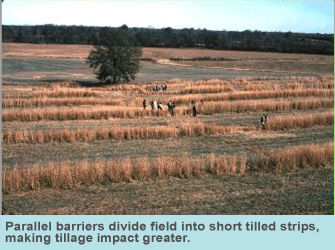Core Principle 4: Conservation Buffers - Vegetative Barriers
Vegetative barriers (also referred to as grass hedges) are narrow, parallel strips of stiff, erect, dense grass planted close to the contour. These barriers cross concentrated flow areas at convenient angles for farming. This practice differs from other conservation buffers because vegetative barriers are managed in such a way that any soil berms that develop are not smoothed out during maintenance operations. Vegetative barriers can be used for the following purposes:
- Control sheet and rill erosion, trap sediment, and facilitate benching of sloped cropland
- Control rill and gully erosion and trap sediment in concentrated flow areas
- Trap sediment at the bottom of fields and at the ends of furrows
- Improve the efficiency of other conservation practices
Coarse, stiff, hedge-forming grasses can withstand high water flows that would bend and overtop finer vegetation. They retard flow velocity and spread out surface runoff. Reduced velocity prevents scouring, causes deposition of eroded sediment, and lessens ephemeral gully development. Vegetative barriers can also disperse flow where water enters other types of conservation buffers, increasing the efficiency of these practices. Placing vegetative barriers on the landscape divides fields into cropped and vegetative strips. Under tillage, soil moves downslope from the upper part of each cropped area and is deposited upslope of the next barrier, gradually leveling the tilled area and creating small terraces. The practice can be applied to all eroding areas, including but not limited to cropland, pastureland, rangeland, feedlots, mined land, gullies, and ditches.
Vegetation should be established that has a density of at least 50 stems per square foot in all barriers. A barrier should be designed to be at least 3 feet wide. If barrier vegetation is so tall-growing that mowing is needed to minimize crop shading, barriers may be made wider to accommodate available mowing equipment. Selection of vegetative species should consider characteristics such as stem strength, plant density, invasive growth, and whether it is a host for insects and disease pests in the region. Certain native and exotic (non-native) grass species have proven to be effective for establishing vegetative barriers; but, some species of non-native plants can become pests that may require expensive eradication. The safest approach is to use native plant species only. Moreover, many native grasses are more chemical resistant and will not die from runoff from the adjacent agricultural field. Some nurseries can provide information on their native vs. non-native plants as well as what risks may exist for the non-native plant species to spread invasively and cause problems.
![[logo] US EPA](https://www.epa.gov/epafiles/images/logo_epaseal.gif)
